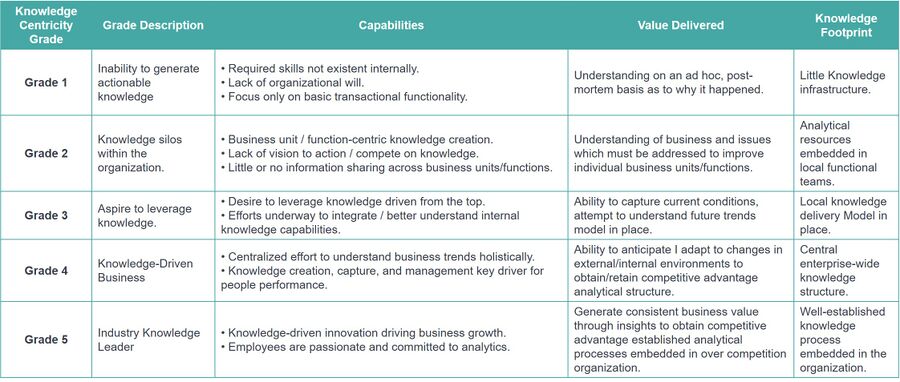Knowledge Management: Difference between revisions
No edit summary |
|||
| (51 intermediate revisions by 2 users not shown) | |||
| Line 1: | Line 1: | ||
'''The Secure Group knowledge management strategy enables our organization to create, apply, and share information, breaking down silos and increasing the usage of valuable data.''' | '''The Secure Group knowledge management strategy enables our organization to create, apply, and share information, breaking down silos and increasing the usage of valuable data.''' | ||
</br> | </br> | ||
In Secure Group, we developed a culture in which people feel independent and autonomous when working. We believe traditional rigid management structures do not create a supportive environment, but cause unnecessary stress and distracts employees, which jeopardizes performance. Because of that, we respect our people's skills and knowledge and support them to pursue the company’s goals in their own way. This mutual respect between parties is essential to our Knowledge Management strategy and we can only afford this level of trust in our people if we know they are fully capable of doing their work and can fill any knowledge gaps quickly and efficiently. | |||
It's a no-brainer that knowledge enables us to grow and innovate. But, it's a fact also that this is easier said than done. Before we reached our ideal Knowledge Management strategy, we faced some problems as the old way we managed information at Secure Group was inefficient. Information was shared in a fragmented way, through email and messaging apps. When people needed information, they’d go to an expert and ask them, which not only wasted time but would only benefit one person. It was difficult for the person to retain the new information, especially if it was shared in passing conversation or buried among emails. The process was also not being overseen, so embellishments and inaccuracies could slip through, which could jeopardize the information. Finally, when a knowledge gap formed, we had no way to fill it, as the one-to-one nature of knowledge sharing was impossible to scale, and the gap would remain. | |||
</br> | |||
After learning from these past mistakes, we then decided where knowledge should NOT be. We realized our knowledge should be easily accessible by our employees. It should not be stuck in someone’s head, where it is of no use to anyone but the person - it would even be unhelpful since people would constantly interrupt their work with questions. It should also not be chaotically thrown around emails and messages, where it is impossible to track and collect. Nor should it be dumped in guides and manuals and be forgotten about, becoming obsolete and misleading. | |||
To ensure the effectiveness of our knowledge management strategy we also defined knowledge sharing as criteria in the Levels of our Frameworks so to progress with us, individuals must demonstrate the capability of sharing knowledge in a structured way. | |||
= Knowledge Categories = | |||
There are three basic forms of knowledge to consider when it comes to knowledge management: explicit, implicit, and tacit. Knowledge management is such a complex process that there are numerous terminologies, solutions, and techniques. Knowledge-driven businesses like ours have the advantage to drive efficient business activities by applying readily-available knowledge from a comprehensive, well-managed knowledge base. Knowledge in a business setting refers to the development of an organization's abilities, experiences, capabilities, and insight. | |||
All this is created, managed, and stored in the form of explicit knowledge, which is the focus of Individual Contributors, and tacit knowledge, which is the manager's focus. | |||
[[File:KNOWLEDGE.png|500px|center]] | |||
</br> | </br> | ||
To make it clearer, we separated the data and information into Extensive Knowledge, Realms Knowledge, and Secure Group Knowledge. | |||
== Extensive Knowledge == | |||
Also known as KAI of the framework, this is about understanding the usage and configuration of a diverse set of tools/software/platforms, languages, protocols, etc. which affect your performance within the company. They are related to the scope of your position and employees should grow this knowledge and hard skills on their own, while the company will provide context on the application of the tool/software/platform within defined processes. | |||
== [[Secure Group Knowledge|Secure Group Knowledge]] == | |||
This is all about understanding the company’s products, the processes and tools/software/platforms related to their execution, the way all teams work, the concepts that are part of their scope, and how they contribute to the overall corporate strategy. It includes technical knowledge for non-technical people and business knowledge for technical people. For this category of knowledge, we provide pieces of training because this way we can ensure that everyone has the complete knowledge set to be a high-performer in our company. | |||
[[File:Problems-Solution.png|800px|center]] | |||
We | == Realm Knowledge == | ||
We have categorized the concepts that are present in our business and operations into domains of knowledge or activity. When addressing business leadership, each management framework requires proficiency in one or more of such domains, which are called Realms. You can check them all [[Realms|here]]. | |||
Another thing we realized is that person has different ways of learning, advancing, and collaborating. We recognized this and decided to share knowledge in two formats: reading and face-to-face courses with a practical application. Therefore, we share knowledge through our internal wiki Confluence and through our Learning Day. | |||
</br> | = Confluence = | ||
Our wiki acts as a single source of all knowledge for our organization which can be created, edited, and modified by any employee. Confluence functions as a central repository for managing and distributing all company knowledge and information. Here, all co-workers are responsible and accountable for storing internal documentation about company policies, processes, projects or products they are building, common workflows, procedure checklists, and more.</br> | |||
We currently have [[Team_Management#Department|Departments]] spaces composed of standard operation procedures, playbooks, how-to-guides and processes documentation, [[Team_Management#Team|Teams]] spaces composed of operational artifacts and [[Team_Management#Division|Divisions]] spaces hyperlinking all the content. | |||
The Learning Day is our knowledge- | = Learning Day = | ||
The Learning Day is our knowledge-driven initiative and it occurs on the last Tuesday of each month. It is a whole day dedicated to Learning. We start with breakfast at 9h00 filled with brain booster food and after that, we start the training according to the following formats: | |||
* Tech Challenges: consist of a presentation with an instructor that will act as a facilitator for the employee to assimilate the knowledge. After the training, employees receive a Tech Challenge to prove that they are capable of completing tasks relating to what they just learned. | * Tech Challenges: consist of a presentation with an instructor that will act as a facilitator for the employee to assimilate the knowledge. After the training, employees receive a Tech Challenge to prove that they are capable of completing tasks relating to what they just learned. | ||
* Tech Sessions: consist of a collaboration activity or open format seminar. It can be given by an external | * Tech Sessions: consist of a collaboration activity or open format seminar. It can be given by an external trainer and it also comes with a task to be completed that varies from topic to topic. | ||
After the completion of a training session, you will receive a challenge to prove you are capable of completing tasks related to what you just learned. They are usually short exercises to test you. | |||
== | = Knowledge Accountability Index = | ||
Secure Group is all about accountability: and that includes accountability in knowledge. Once information is systemized and available to all, it becomes measurable and this allows it to be considered within the employees’ performances. In order to manage the existing knowledge in the company and to promote such accountability, we created a Knowledge Accountability Index a.k.a. KAI. | |||
</br> | </br> | ||
To help us measure competency in a skill, the index describes the grades of everyone’s ability and competency in a specific occupation. It is separated into six grades, each outlining the capabilities and value to be delivered by the person, and allowing them to plan their learning journey. These range from “Fundamental awareness” to “Expert”. The index can be used by an individual to compare their current level of proficiency to top performers in the same occupation and it enables us to: | |||
* Centralize effort to understand technology trends from a holistic view | * Centralize effort to understand technology trends from a holistic view | ||
| Line 109: | Line 57: | ||
In Secure Group, the effective management of knowledge aids competitive advantage. When people are accountable for knowledge it can be shared more efficiently and productively. We have put in place systems and good processes to achieve this so armed with knowledge, our employees are better able to innovate in their work. | In Secure Group, the effective management of knowledge aids competitive advantage. When people are accountable for knowledge it can be shared more efficiently and productively. We have put in place systems and good processes to achieve this so armed with knowledge, our employees are better able to innovate in their work. | ||
== | == Knowledge Grade Description == | ||
This scale serves as the guide to understanding the expected proficiency in each grade. | |||
[[File:KAI.png|800px|center]] | |||
[[File:Grade_Description.jpg|center|900px]] | |||
= Company Knowledge Centricity Level = | |||
Our current situation is represented by Grade 2 and Grade 3 depending on the department. '''Our strategic goal is to achieve Grade 5 by the middle of next year'''. | |||
[[File:Knowledge_Centricity_Grade.jpg|900px|center]] | |||
| | |||
| | |||
Latest revision as of 08:47, 1 August 2022
The Secure Group knowledge management strategy enables our organization to create, apply, and share information, breaking down silos and increasing the usage of valuable data.
In Secure Group, we developed a culture in which people feel independent and autonomous when working. We believe traditional rigid management structures do not create a supportive environment, but cause unnecessary stress and distracts employees, which jeopardizes performance. Because of that, we respect our people's skills and knowledge and support them to pursue the company’s goals in their own way. This mutual respect between parties is essential to our Knowledge Management strategy and we can only afford this level of trust in our people if we know they are fully capable of doing their work and can fill any knowledge gaps quickly and efficiently.
It's a no-brainer that knowledge enables us to grow and innovate. But, it's a fact also that this is easier said than done. Before we reached our ideal Knowledge Management strategy, we faced some problems as the old way we managed information at Secure Group was inefficient. Information was shared in a fragmented way, through email and messaging apps. When people needed information, they’d go to an expert and ask them, which not only wasted time but would only benefit one person. It was difficult for the person to retain the new information, especially if it was shared in passing conversation or buried among emails. The process was also not being overseen, so embellishments and inaccuracies could slip through, which could jeopardize the information. Finally, when a knowledge gap formed, we had no way to fill it, as the one-to-one nature of knowledge sharing was impossible to scale, and the gap would remain.
After learning from these past mistakes, we then decided where knowledge should NOT be. We realized our knowledge should be easily accessible by our employees. It should not be stuck in someone’s head, where it is of no use to anyone but the person - it would even be unhelpful since people would constantly interrupt their work with questions. It should also not be chaotically thrown around emails and messages, where it is impossible to track and collect. Nor should it be dumped in guides and manuals and be forgotten about, becoming obsolete and misleading.
To ensure the effectiveness of our knowledge management strategy we also defined knowledge sharing as criteria in the Levels of our Frameworks so to progress with us, individuals must demonstrate the capability of sharing knowledge in a structured way.
Knowledge Categories
There are three basic forms of knowledge to consider when it comes to knowledge management: explicit, implicit, and tacit. Knowledge management is such a complex process that there are numerous terminologies, solutions, and techniques. Knowledge-driven businesses like ours have the advantage to drive efficient business activities by applying readily-available knowledge from a comprehensive, well-managed knowledge base. Knowledge in a business setting refers to the development of an organization's abilities, experiences, capabilities, and insight. All this is created, managed, and stored in the form of explicit knowledge, which is the focus of Individual Contributors, and tacit knowledge, which is the manager's focus.
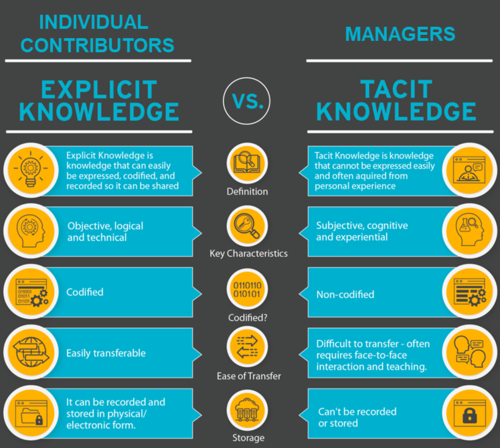
To make it clearer, we separated the data and information into Extensive Knowledge, Realms Knowledge, and Secure Group Knowledge.
Extensive Knowledge
Also known as KAI of the framework, this is about understanding the usage and configuration of a diverse set of tools/software/platforms, languages, protocols, etc. which affect your performance within the company. They are related to the scope of your position and employees should grow this knowledge and hard skills on their own, while the company will provide context on the application of the tool/software/platform within defined processes.
Secure Group Knowledge
This is all about understanding the company’s products, the processes and tools/software/platforms related to their execution, the way all teams work, the concepts that are part of their scope, and how they contribute to the overall corporate strategy. It includes technical knowledge for non-technical people and business knowledge for technical people. For this category of knowledge, we provide pieces of training because this way we can ensure that everyone has the complete knowledge set to be a high-performer in our company.
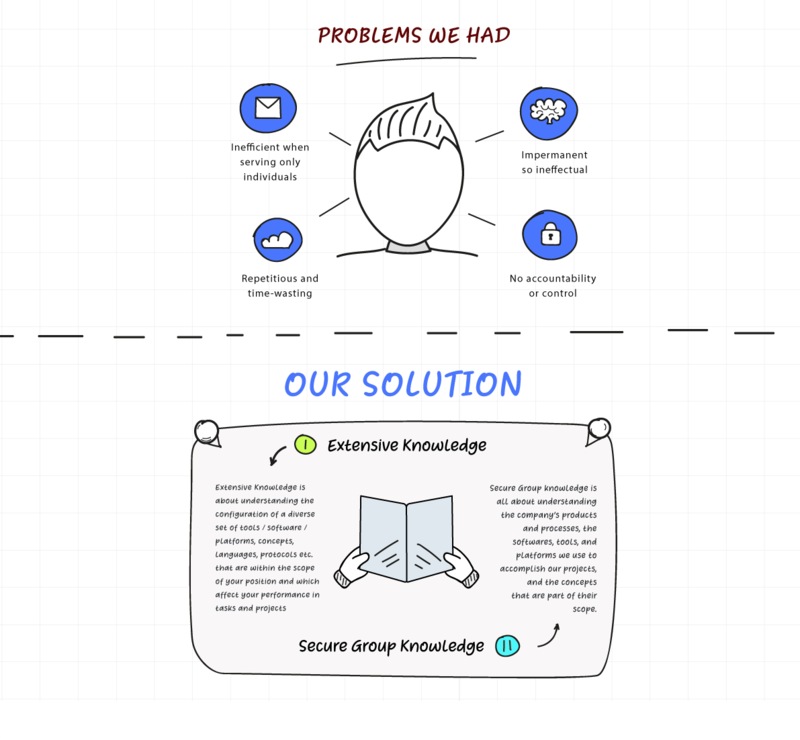
Realm Knowledge
We have categorized the concepts that are present in our business and operations into domains of knowledge or activity. When addressing business leadership, each management framework requires proficiency in one or more of such domains, which are called Realms. You can check them all here.
Another thing we realized is that person has different ways of learning, advancing, and collaborating. We recognized this and decided to share knowledge in two formats: reading and face-to-face courses with a practical application. Therefore, we share knowledge through our internal wiki Confluence and through our Learning Day.
Confluence
Our wiki acts as a single source of all knowledge for our organization which can be created, edited, and modified by any employee. Confluence functions as a central repository for managing and distributing all company knowledge and information. Here, all co-workers are responsible and accountable for storing internal documentation about company policies, processes, projects or products they are building, common workflows, procedure checklists, and more.
We currently have Departments spaces composed of standard operation procedures, playbooks, how-to-guides and processes documentation, Teams spaces composed of operational artifacts and Divisions spaces hyperlinking all the content.
Learning Day
The Learning Day is our knowledge-driven initiative and it occurs on the last Tuesday of each month. It is a whole day dedicated to Learning. We start with breakfast at 9h00 filled with brain booster food and after that, we start the training according to the following formats:
- Tech Challenges: consist of a presentation with an instructor that will act as a facilitator for the employee to assimilate the knowledge. After the training, employees receive a Tech Challenge to prove that they are capable of completing tasks relating to what they just learned.
- Tech Sessions: consist of a collaboration activity or open format seminar. It can be given by an external trainer and it also comes with a task to be completed that varies from topic to topic.
After the completion of a training session, you will receive a challenge to prove you are capable of completing tasks related to what you just learned. They are usually short exercises to test you.
Knowledge Accountability Index
Secure Group is all about accountability: and that includes accountability in knowledge. Once information is systemized and available to all, it becomes measurable and this allows it to be considered within the employees’ performances. In order to manage the existing knowledge in the company and to promote such accountability, we created a Knowledge Accountability Index a.k.a. KAI.
To help us measure competency in a skill, the index describes the grades of everyone’s ability and competency in a specific occupation. It is separated into six grades, each outlining the capabilities and value to be delivered by the person, and allowing them to plan their learning journey. These range from “Fundamental awareness” to “Expert”. The index can be used by an individual to compare their current level of proficiency to top performers in the same occupation and it enables us to:
- Centralize effort to understand technology trends from a holistic view
- Define knowledge as a key component in high performance
- Anticipate and adapt to changes in external/internal environments to obtain/retain a competitive advantage in a quantifiable structure
In Secure Group, the effective management of knowledge aids competitive advantage. When people are accountable for knowledge it can be shared more efficiently and productively. We have put in place systems and good processes to achieve this so armed with knowledge, our employees are better able to innovate in their work.
Knowledge Grade Description
This scale serves as the guide to understanding the expected proficiency in each grade.
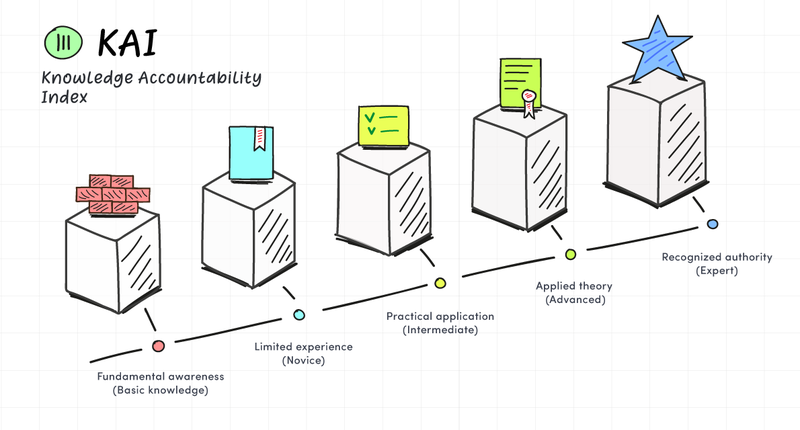
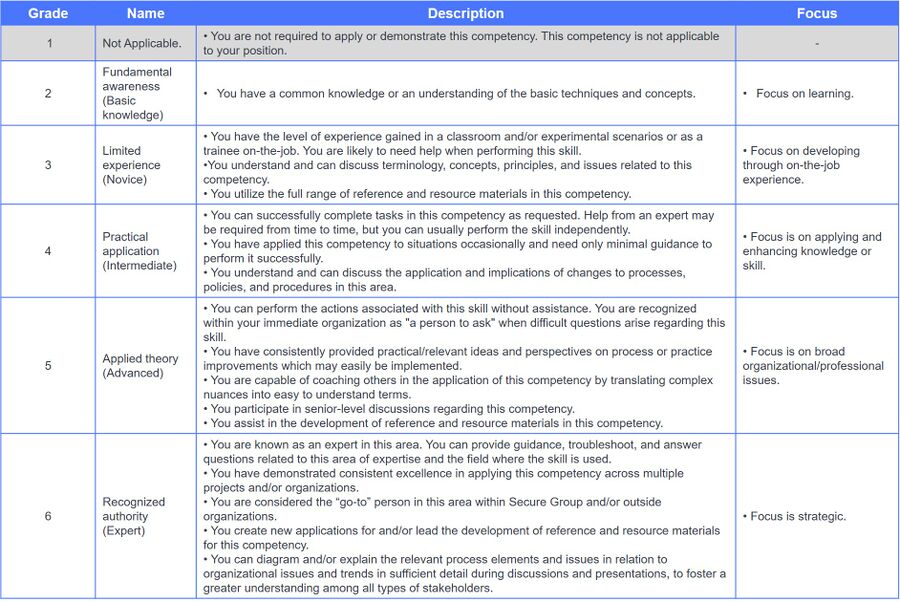
Company Knowledge Centricity Level
Our current situation is represented by Grade 2 and Grade 3 depending on the department. Our strategic goal is to achieve Grade 5 by the middle of next year.
